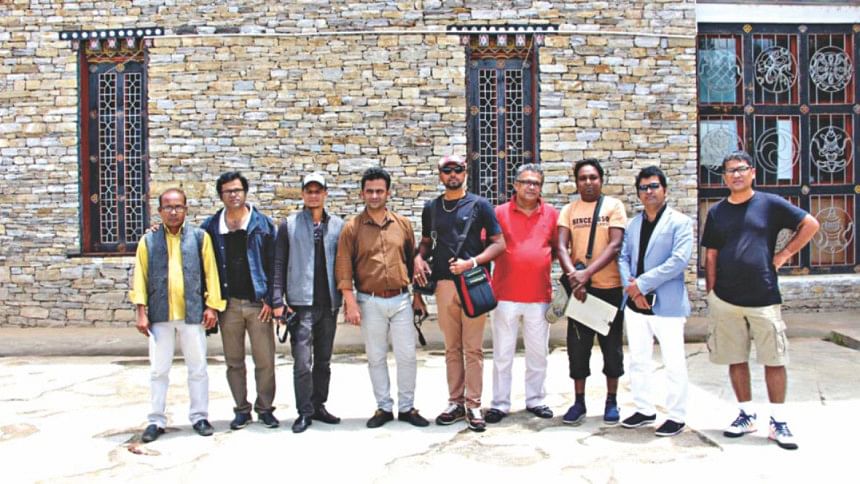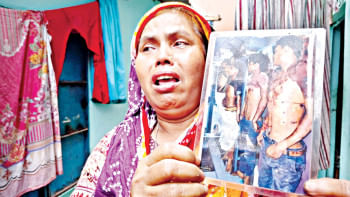An artistic adventure in Bhutan

I was not quite sure if I would have a good time with a dozen of the country's artists going to Bhutan for eight days on an art camp. Bhutan is one of the world's most beautiful countries that needs to be explored. With artists, you are less likely to go places because they rather spend more time capturing the beauty of the country with their paint and brush.
But I could not say no to my friend, Goutam Chakraborty, artist and director of Galleri Kaya, who had organised this 'watercolour' art camp. Besides, I thought this would be an off-beat trip.
Earlier this month, at the airport, I met artists Jamal Ahmed, Ranjit Das, Tarun Ghosh, Ashraful Hasan, Nagarbashi Barman, Anisuzzaman, Shafin Omar, Kamal Uddin, Sheikh Md Rokonuzzaman, Shohag Parvez, Ruhul Amin Tareq and Shahnoor Mamun.
Jamal Ahmed, Ranjit Das and Tarun Ghosh are senior artists—widely known to art lovers. Ashraf, Nagarbashi and Anisuzzaman are on their way to maturing their skills while the rest are young, upcoming and promising artists.
Our flight ended in the blink of an eye in just about an hour. We landed at the Paro airport at 10am. As Bangladesh and Bhutan are in the same time zone, there was no need for us to adjust our watches.
Bangladeshis are among the very few highly privileged foreign nationals who do not require any visa for entering Bhutan. All foreigners, except for Bangladeshis, Indians and Maldivians, must pay a US $250 per day fee to obtain the visa. So we hit the road within minutes after getting our passports stamped by smiling immigration officers.

We started off for Thimbu by bus and soon the group chemistry began to work. Jamal bhai, being one of the most senior artists in the group, broke the ice by revealing his sense of humour. After a while, we stopped at a road side shop that showcased some fruits—apples, pears and plums. The artists grabbed some fruits and someone pointed out, “Watch out! You might get an upset stomach—these fruits are chemical free!”
Soon we resumed our journey. Thimbu is only around 65 km off Paro.
It took us less than two hours through the mountainous roads over 7000 feet above the sea level to reach Jhingham Resort in the heart of Bhutanese capital.
Perched on a mountain side in the valley city, we had to climb stairs to go to our rooms. Mind you, even if you are used to climbing stairs, in Bhutan it's more strenuous as the air has less oxygen than that of Dhaka. Due to the higher altitude, Bhutanese people have higher haemoglobin levels than Bangladeshis and thus we need to adjust to the reduced oxygen level.
For most of the young artists in the group, this was their first trip to Bhutan and they were simply overwhelmed by the landscape and the clouds on the bright, sunny sky. For anyone coming from Dhaka, the weather of Bhutan is very comfortable in August with temperatures reaching only as high as 25 degrees, and as low as 13 or 14 degree Celsius.
The first day was spent visiting some city spots and relishing the food, including the famous Emadatsi - green chilly cooked in cheese.
On the next day, we visited Dochula Pass (3,100 metres or 10,200 ft from the sea level) and some other popular tourist attractions in Thimbu before officially launching the art camp in the evening. Artists took up their paints and brushes, sat in their rooms or verandas and then most of them fell asleep. Oh well never mind!
The next morning, the scenario was different. The artists were now busy studying the landscape, the city, the rapid Wangchuk River down below and the ever changing cloud-scape. Goutam da finally seemed happy.
After watching the artists for a while, I began to feel like Picasso. So I stole a piece of charcoal and a painting sheet and made my hands and papers all dirty. Nothing useful came out.

Every evening, we assembled at the beautiful dining place for long chat sessions, where Jamal bhai would continuously cut one joke after another while relishing delicious Bhutanese food, which can be very hot as Bhutanese people have a fascination for chillies - both green and red. If you ever go to Bhutan, please try out the Emadatsi, if not anything else.
The artists then posed with the beautiful attendant girls of the resort (I was trying to draw them in charcoal, by the way, in my own cartoonistic way).
Our young artist Shohag, who had just exchanged rings with the love of his life and was regularly hooked on the phone talking to her, posed with two female attendants. The tech savvy artist then “in-boxed” the picture in his Facebook messenger to share with his friend Kamal but instead sent it to his fiancée!
“She has switched off her phone!” Shohag said with a nervous smile as we were boarding our bus to start for Paro after four days.
In the bus, the others started taunting Shohag, who maintained that he was not worried at all. “The thing is why would your girl all of a sudden receive your photo with some Bhutanese beauties?” I asked, “What would be your explanation?”
“I would say that is the custom here…maybe!” he joked.
Someone else said from back of the bus, “Coming soon to your nearby theatre—Inbox! The Romantic Action Comedy!”
Amid the laughter (and Shohag's nervousness – it's alright smile), we reached Paro. We made a visit to the Bhutan National Museum and the Rinpung Dzong (Bhutanese monastery and fortress), ate some before landing in Gangtey Palace resort.
Gangtey Palace is a wonderful place to stay. This hundred year old structure used to be a property of the first king of Bhutan and is now run by the king's grandchildren. This wood and stone Palace has no in-room television or phone (but has Wi-Fi), and offers a lawn from where you can watch the whole Paro valley. The artists were so captivated by the landscape from this resort that they got into their actions almost instantly.
Mamun was focusing on Bhutanese flora at the lawn of the resort when this Canadian lady, a visitor, came to him asking for the price of his paintings. Mamun was flattered, “Well...er...this is not for sale. Ask Mr Goutam—he will help you,” he said.
Some of them, like Tarun Ghosh, were busy taking photos instead of painting anything. “May be it would be a good idea if we had a photo exhibition with the paintings,” I joked with Tarun da.
The evenings turned into cultural events with the artists performing songs in chorus. And they were so enthusiastic that they took over the kitchen of the resort to cook 'khichuri' the Bangladeshi way and share it with the resort attendants.
“Those who came here for the first time took some time to adjust. The young artists have their own choice of medium —and not all of them are used to water colouring. But then they started enjoying the camp—they were painting both local scenery as well as their own themes,” observed Ranjit Das.
“I came here before,” said Jamal Ahmed, “the scenic landscape all around which deserves to be painted in acrylic. So I took some pictures. I will paint in acrylic when I return to Dhaka. The works involving clouds will be best expressed in acrylic.”
The group returned to Dhaka after eight days with more than 90 works of art. “I hope by the end of the year, art lovers will get a chance to see these works at Galleri Kaya,” said Goutam Chakraborty.
By Sharier Khan
Photo courtesy: Galleri Kaya

 For all latest news, follow The Daily Star's Google News channel.
For all latest news, follow The Daily Star's Google News channel. 



Comments